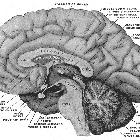germinal matrix haemorrhages














Germinal matrix hemorrhages, also known as periventricular-intraventricular hemorrhages (PVIH), are the commonest type of intracranial hemorrhage in neonates and are related to perinatal stress affecting the highly vascularized subependymal germinal matrix. The majority of cases occur in premature births within the first week of life. They are a cause of significant morbidity and mortality in this population.
Epidemiology
Germinal matrix hemorrhage can only occur when the germinal matrix is present and is therefore only seen in premature infants. Hemorrhages can be identified in 67% of infants born prematurely at 28-32 weeks and 80% of infants born between 23 and 24 weeks of gestation . The majority of hemorrhages (90%) are identified within 4 days of birth, and 40% within the first 5 hours .
Clinical presentation
Clinical presentation for grade I and II bleeds is vague. These are usually found on routine ultrasound performed on premature neonates. With grade III and IV bleeds, respiratory depression or apnea, abnormal posturing, seizures, and bulging fontanelles may be seen .
Pathology
The germinal matrix is formed early during embryogenesis and is the site of glial and neuronal differentiation. From here cells migrate peripherally to form the brain. It is densely cellular and, not surprisingly, also densely vascular .
The blood vessels of the germinal matrix are weak-walled and predisposed to hemorrhage. Significant stress experienced by a premature infant after birth may cause these vessels to rupture. The bleeding occurs initially in the periventricular areas causing a periventricular hemorrhage (PVH). If this bleeding persists, the expanding volume of blood dissects into the adjacent lateral ventricles leading to intraventricular hemorrhage (IVH).
There is a direct relation between prematurity, germinal matrix and thus the number of capillaries in this region: at 32 weeks germinal matrix is only present at the caudothalamic groove. By 35-36 weeks gestation, the germinal matrix has essentially disappeared and thus the risk of hemorrhage is markedly reduced.
Risk factors
- low birthweight
- cyanotic congenital heart disease
- prolonged labor
- multifetal pregnancy
Classification
Grading of neonatal intracranial hemorrhage.
Radiographic features
Ultrasound
This is the investigation of choice since it is portable and does not require sedation. Germinal matrix hemorrhages appear as echogenic regions close to the caudothalamic groove extending along the floor of the frontal horn of the lateral ventricle.
It is important to distinguish hemorrhage from the normal choroid plexus which is also echogenic. The caudothalamic groove acts as a convenient landmark: echogenicity anterior to the groove represents blood as the choroid finishes at the groove .
CT
CT may demonstrate high attenuating regions in keeping with hemorrhage which may or may not also be seen dependently within the ventricles.
With grade IV bleeds, large confluent regions of low density (venous infarction) and patchy regions of hyperdensity (hemorrhage) are seen in the periventricular regions. They are typically flame-shaped .
MRI
The appearance of the hemorrhage will vary according to the age of the bleed (see aging blood on MRI).
Treatment and prognosis
The ideal treatment is the prevention of premature delivery. Antenatal dexamethasone administered to the mother or indomethacin administered to the infant also decrease the incidence, although the exact mechanism by which this occurs is uncertain.
If hydrocephalus is present, CSF drainage may be necessary.
Prognosis depends on the extent of hemorrhage and presence of hydrocephalus (see germinal matrix hemorrhage grading). Grade I and II hemorrhages have a good prognosis, whereas grades III and IV have a poor prognosis, with a 90% mortality for grade IV bleeds .
In grade IV bleeds significant areas of cerebral tissue may be lost, forming porencephalic cysts.
Complications
- post hemorrhagic hydrocephalus
- blockage of villi
- obliterative fibrosing arachnoiditis
- periventricular leukomalacia
- cyst formation
- cavitation of hemorrhage
- subependymal cyst
- unilocular porencephalic cyst
Differential diagnosis
Differential considerations on antenatal ultrasound include:
- normal choroid plexus: does not extend anteriorly to the caudothalamic groove/foramen of Monro
- Intraventricular hemorrhage of the newborn: within the subependymal region, rather than the germinal matrix
- early periventricular leukomalacia: when echogenicity is increased, common in preterm
- hypoxic-ischemic brain injury: involves subcortical cerebral or basal ganglia injury; common in term babies
- TORCH CNS infection: commonly seen with periventricular calcifications
See also
Siehe auch:
- caudothalamic groove
- paediatric intraventricular haemorrhage
- intraventrikuläre Blutung bei Neugeborenen
- subependymale Zyste
- fetal intracranial haemorrhage
- germinal matrix haemorrhage grading
- Foramen interventriculare Monroi
- Grading bei intrakranieller Blutung bei Neugeborenen
und weiter:

 Assoziationen und Differentialdiagnosen zu Blutungen der germinalen Matrixzone:
Assoziationen und Differentialdiagnosen zu Blutungen der germinalen Matrixzone:

